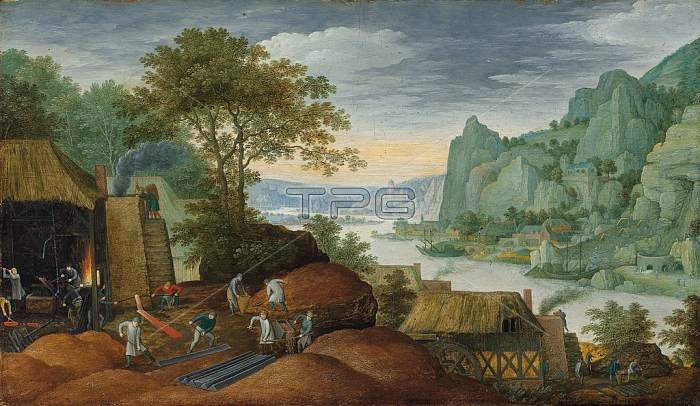
3504152 A rocky landscape with figures by an iron foundry, a river and houses on the bank beyond (oil on panel) by Ryckaert, Marten (1587-1631); 30.2x50.2 cm; Private Collection; (add.info.: Long claimed to be ???he oldest painting of a blast furnace and finery in Europe??(Historical Metallurgy Society, 2011, op. cit.). ?vrard notes that the depicted furnace is a pyramidal tower with a broad, flat opening, some five or six metres high (to judge by the relative height of the figures). It is built of hewn stone, with a stone stairway built up against one side, which provides access to the inlet at the top (???ueulard??. The ???alloon Method??is one of the most important developments in the history of the industrial production of iron, named after the Walloon region of present-day Belgium. The Method consisted of making pig iron in a blast furnace, followed by refinement in a finery forge. The process was devised in the Liege region and soon spread into France, the Low Countries and thence to England, finding employment there before the end of the fifteenth century. In the early-seventeenth century, it was taken to Roslagen in Sweden by Louis de Geer, who attracted Walloon ironmakers to the new works there; iron made there by the Walloon Method was known in England as oregrounds iron, and by the eighteenth century was regarded as the best grade of iron available. The technical breakthrough came at a moment when all eyes were on the iron industry. European rulers sent their armies far and wide in the defence of competing territorial claims both on the Continent and, with the discovery of the Americas in 1492, in the New World, and with the technology and thus the terms of battle rapidly changing, all the players were engaged in a bitterly contested arms race ??stronger armour or more fearsome firepower could give the winning side just the edge it needed. The invention of a process which produced higher-grade iron in Wallonia placed the region in the limelight. Possession of the Wallonian territories came to be a valuable asset. In the early-sixteenth century, the Holy Roman Emperor Charles V took pains to secure the rocky plains of Wallonia, rich in natural resources and the technical skills of its inhabitants. ); Photo 穢 Christie\'s Images.
| px | px | dpi | = | cm | x | cm | = | MB |
Details
Creative#:
TOP27574774
Source:
達志影像
Authorization Type:
RM
Release Information:
須由TPG 完整授權
Model Release:
No
Property Release:
No
Right to Privacy:
No
Same folder images:

 Loading
Loading